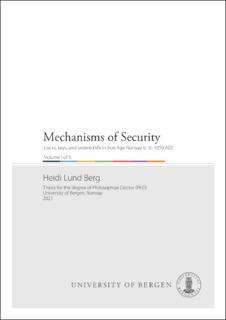| dc.description.abstract | This thesis examines the technological and social parameters for, and the social impact of, the introduction and implementation of locking into Norway in the Iron Age, based on analyses of locks and keys. The functional properties of locking devices and their practical applications as security mechanisms constitute the focal point of the study, and the basis for discussing how locking contributed to the ordering and organisation of life and society in the course of the first millennium AD.
The main aims are to establish an empirical foundation for the study of locking devices and to understand locks and keys as a technological and social phenomenon which was affected by and had effects on the societies that created and used them. The archaeological material is approached from a conceptual framework centred on perspectives of entanglement and social boundaries, in which locking is considered a social practice. As material agents locks and keys are seen as involved in the physical protection of things and spaces, regulation of access, and manifestation of ownership rights, as well as the creation and negotiation of values and norms as part of social order.
The analytical material is comprised by more than eight hundred locks and keys dated from the Roman Period to the Viking Age, deriving from burials, depositions, and settlements, as well as single finds. The finds are used in the construction of renewed classifications for Scandinavian locks and keys, which is based on their functional designs and their correlation to lockable containers, doors, and fetters. Through temporal, spatial, and contextual analyses of types the thesis outlines a complex picture of production, innovation, distribution, and application of locking devices. The results illustrate that locks and keys were introduced and developed in stages in Norway, and that their use expanded and diversified practically as well as socially. The analytical patterns are further discussed in terms of security, ownership, and order, arguing that locking from its introduction became gradually embedded into society during the Iron Age. This is suggested to result from the success of locks and keys in achieving order, and their close relationship with processes of hierarchisation, social differentiation, and social complexity.
The thesis provides new insights into the practical functions and applications of diverse locking mechanisms, technological development, craft specialisation, exchange and contact networks, and the social impact of locking in terms of physical and social order. It also contributes to current debates concerning social organisation and transformations within Norway and wider Scandinavia and Northern Europe in the first millennium AD. | en_US |

